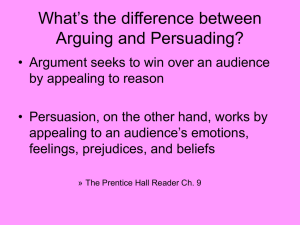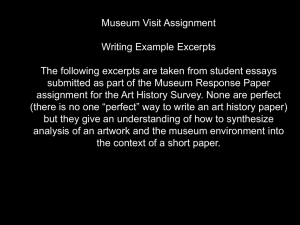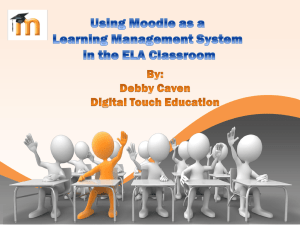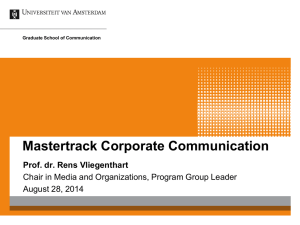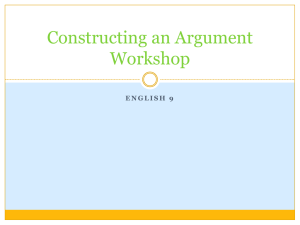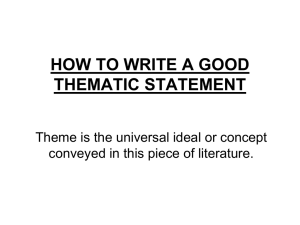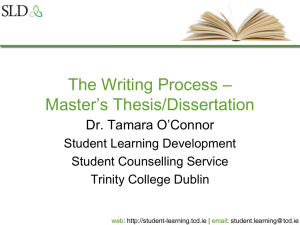ppt
advertisement
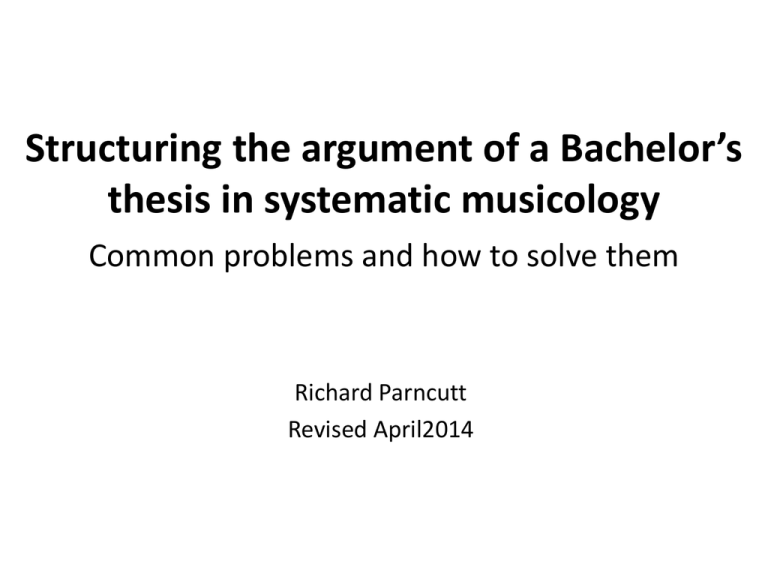
Structuring the argument of a Bachelor’s thesis in systematic musicology Common problems and how to solve them Richard Parncutt Revised April2014 Title page • Problem: Missing information – Include title of essay, your name, matriculation no., name of course, semester of course, name of instructor, name of university, date of draft • Problem: A photo without a source – Unnecessary! There is no need to decorate student essays – You must state the source of any photo Abstract (1) • Problem: Abstract is missing – – – – – – – – It should clarify the structure of your argument Structure it like the main text (e.g. 1 sentence per heading) Don’t talk about the text’s structure (not “in the intro…”) Write grammatically complete sentences It is ok to reproduce phrases verbatim from main text Make abstract understandable independently of main text Make it as informative as possible about your topic Include main keywords for electronic literature search Abstract (2) • Problem: Abstract has introductory character – – – – – – should instead summarize main theses and arguments should be more concise than introduction should not cite literature should not refer directly to the structure of the paper every point in abstract should be expanded in main text the last sentence should be about implications or outlook Abstract (3) • Problem: Abstract is monolingual – – – – Generally write two abstracts! One German, one English Same content - but maybe quite different linguistic structures About half a page or 1000 characters each Give both abstracts a title title in 2 languages for Zeugnis in Uni Graz Online Headings • Problem: Text contains no headings – Your text must contain at least three headings: “Introduction”, one of more headings describing the content of the main section (but not “Main section”), and a heading for the final section (e.g. “Conclusion”, “Discussion”, “Implications” etc.) – Subheadings are also possible but usually unnecessary. In that case follow APA style: Main headings are centered and subheadings are on the left. Citation style • Problem: Unclear or inconsistent citation style – Indicate it on the title page, e.g. “Citation style: APA” – Use only international standard styles (Chicago or MLA for humanities; see Wikipedia “citation style”) – Read the style guidelines and implement them! – Too many deviations no grade! (Sorry, I don’t have time to correct citation style. Please take responsibility for it.) Writing style (1) • Problem: Writing is not informative – Tip: avoid negative statements, e.g. “According to the Institute of Y there is no universally accepted definition of X”. Instead, talk about what X really is (in your opinion and in accordance with relevant literature) • Problem: “Bla bla” – Get to the point. No need for e.g. “Throughout the years, the scientific interest in this topic grew, and several researchers investigated the effects of …”. Either write directly about the research or skip it. Writing style (2) • Problem: Text wanders, lacks direction – Solution: a clear hierarchical structure (your “argument”) – A clear narrative structure (superposed on the hierarchy) • Problem: Poor paragraph structure – – – – – Clarify the topic of each paragraph in the first sentence. The rest of the paragraph should address only that topic. A good paragraph has about 3 long or 6 short sentences. The next paragraph should have a different topic. Similar principles apply to sections (next hierarchical level). Writing style (3) • Problem: Unnecessary superlatives – The word “very” usually says nothing. Delete it! – Avoid exclamation marks too! For the same reason;-) – Tip: It’s acceptable to use exclamation marks in teaching guidelines, but not in academic texts!!! • Problem: Journalistic rather than academic style – E.g. spicing up your text with linguistic tricks and clichés – Instead, write (or construct) direct, clear sentences – Make your text interesting by talking about interesting things Your main thesis • Problem: Identical to a claim in the literature – You should depart in some way from the literature – Justify departure by comparing sources • Problem: Attempt to “prove”/“verify” the thesis – – – – – In general, you can support a thesis but not prove it The aim is instead to investigate possible theses Look for arguments for and against each one After that, conclude that one is (more) correct This procedure aims to convince critical expert readers • Problem: Thesis or argument is too trivial – If it’s obvious, it’s also uninteresting – Don’t forget to seriously consider some counterarguments Possible theses • Problem: list of possible theses is too trivial, e.g. – The mentioned effect is positive – The effect is negative – There is no effect • The above is ok for an empirical paper. For a theoretical paper you might instead ask why? – Reason or process no. 1? – Reason or process no. 2? (etc.) Intro: Present and explain this list in narrative text. Main part: Refer somewhere to each possible thesis. Conclusion: One of them becomes your main thesis. Terminology from this guideline • Problem: Unnecessary reference to “my thesis”, subtopic 1”, “thesis implications”… – – – – Avoid this terminology as far as possible Headings should generally reflect content not structure In the main section, the main headings are the subtopics Convert all lists from tabular argument into narrative text Structure (1) • Problem: Paper talks about its own structure – Your text should implement the structure of the tabular argument without talking about it – E.g. avoid talking about “defining terms,” just do it! Don’t write e.g. “At the beginning of this part two terms have to be defined” – Don’t write “As mentioned already earlier in this paper, …”. Just get to the point! – Exception: at end of the introduction, describe the structure of the rest of the paper Structure (2) • Problem: Too much summarising of sources – Your own argument should make up most of the text – It is ok to occasionally and briefly summarize the main points of a primary source (e.g. in < 100 words) – See my page on academic independence – See ppt guidelines to SE “music psychology” on topicdriven (PS) versus thesis-driven (SE) work Introduction (1) • Problem: Inappropriate order of material – Illustrative examples should be early – General background should be early (e.g. social, cultural, political, historic context) – Explanation of structure of main part: only at the end Introduction (2) • Problem: No background in relevant disciplines – Don‘t just list the relevant disciplines – Make concrete claims about your main question that most people in those disciplines would support – Refer to literature Main section • Problem: Main section not detailed enough – Read the literature! – Organise material according to your structure – Build up a detailed, tightly organised account • Details do not refer directly to stated theses – Think about every noun, verb and adjective in your own thesis. What evidence might there be for or against it? Conclusion • Problem: Arguments for and against your thesis do not refer to the thesis as formulated – Make sure your thesis is well formulated. Refer only to that formulation! • Problem: Discussion of methodological limitations of sources is too superficial – If there are no obvious problems, don’t invent any – E.g. it is almost a cliché to write “not enough participants” Further research • Problem: Suggestions for further research do not address exact formulation of your thesis – Omit general suggestions about research on your topic – Refer only to the exact formulation of your thesis – Same applies to possible research methods Figures and tables • Problem: Copied/scanned from published paper – Prepare your own graph or table based on data from one or more (!) articles relevant to your specific question – We are learning to write academic articles for publication in which figures and tables should be original The process of researching and writing • Problem: Talking about this process – The reader is interested in content, not what you did – Not e.g. „It was hard to find literature on topic X” Literature (1) • Problem: Not enough good literature cited (“good” = peer-reviewed or frequently cited) – – – – Find out if your literature is “good” If not, consider changing or revising your topic Generally cite “good” literature more often Your final literature list should be about 3 pages – much longer than for the preceding seminar! Literature (2) • Problem: Unclear origin of ideas – Make the origin of your main ideas clear – Usually every paragraph contains a reference - from the start of the introduction to the end of the conclusion • Problem: Referring to research without citing it – Don’t write “research shows…” or “many researchers have found…”. Instead, cite the literature directly Tabular argument (1) • Problem: Table is missing – You worked hard on it, so please include it as an appendix • Problem: Table is incomplete – It must include introduction, main part and final part and most ingredients of each part • Problem: Table does not correspond to text – Everything in the tabular argument should be expanded into the main text (includes the examples at the start) – When writing the text you will get ideas for revising the table. So move back and forth between text an table – E.g. you may revise a subthesis or the main thesis this way Tabular argument (2) • Problem: Table is not concise enough – Should be less than one page each for Introduction, Subtopic 1, Subtopic 2, …, Conclusion • Problem: Illogical structure of thesis, subtheses… – Present the structure in class! We will discuss • Not enough good, diverse evidence for thesis – Search literature again - or change thesis (English) language • Problem: So poor that it is difficult to read – Ask for help – Practice giving presentations in English Length • Problem: Length guidelines for bachelor’s theses in humanities (incl. Musikologie) – Theses in the sciences are typically about 20% shorter; AND – If your table is 4 pages, you can count it as up to 8 pages; AND – You can count the abstract as part of the text instead of 30-40 pages for main text, you can submit 20-25 A longer thesis is ok if you solved all problems in this guideline;-) Submission • Problem: Only electronic copy submitted – Please also print it, with two pages reduced onto one side (I also like double-sided) and staple the pages together • Problem: Only paper copy submitted – Please also send an email attachment (preferably pdf) – I may later put it in the internet if we both agree, e.g. here: http://www.uni-graz.at/~parncutt/fk2_mitglieder.html – I may recommend that you revise according to my comments before publication


